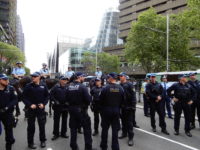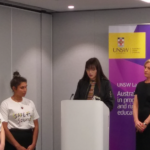“Systemic Unlawfulness”: An Interview With Dr Vicki Sentas on Police Powers

Unsurprisingly, the recently released Rethinking Strip Searches by NSW Police report drew the ire of the force. Commissioned by the Redfern Legal Centre, the UNSW report caused reigning state police commissioner Mick Fuller to criticise it very publicly.
At a 29 August budget estimates hearing, Fuller suggested that the researchers needed to do more work on their statistics, while in mid-September, the top cop tried unsuccessfully to prevent the strip search document being added to the record of the state inquest into deaths at music festivals.
The strip search report sets out that between 2006 and the present, the strip searches by NSW police have increased twentyfold. And it calls for an overhaul of strip search laws, so as to clarify – in a more precise way – how officers of the law should be carrying out this invasive practice.
Police strip search protocols are set out in the Law Enforcement (Powers and Responsibilities) Act 2002 (NSW), commonly known as the LEPRA. Section 32 of the Act states that a strip search can only be conducted in the field when “the seriousness and urgency of the circumstances” make it necessary.
Policing potentials
Another controversial report on police powers was the 2017 Policing Young People report. The document raised public awareness around a secretive program that NSW police has been running since 2000, called the Suspect Targeting Management Plan (STMP).
The STMP is a secret blacklist that contains the names of individuals, who are targeted by police for increased surveillance. This includes being stopped and searched, or having officers check on individuals at home. Of concern is the fact that an STMP target doesn’t even need to have a criminal record.
One of the most disturbing aspects of this program, researchers found, was it disproportionately targets young Aboriginal people. The data from five local area commands revealed that over a two year period, 54 percent of STMP targets were First Nations people.
This disproportionate targeting of Aboriginal youth is made even starker, when one takes into account that Indigenous people only make up 3.4 percent of the overall population in this state. Researchers also found that the socially damaging STMP has no real impact on crime.
Academic oversight
Dr Vicki Sentas co-authored both reports. The doctor is a UNSW Faculty of Law senior lecturer in criminal law, criminology and policing. And she has a focus on police powers and racialisation in law and police activity.
At the August launch of the strip search report, Dr Sentas made clear that “strip searches are not a normal part of policing”. And she added that these intimidating procedures should only be reserved “for genuine emergencies, where there is an imminent risk to someone’s safety”.
Sydney Criminal Lawyers spoke to Dr Sentas about the implications of the strip search report findings, her take on the shift towards policing that deals with future crime, and why law reform is a necessary component of bringing about a change in police practice and culture.
Firstly, you co-authored the Rethinking Strip Searches by NSW Police report. Dr Sentas, in undertaking your research, what would you say struck you the most about the use of strip searches by police in this state?
Lawyers have been saying for years that police have been strip searching people without a lawful basis. And people have been coming forward with some shocking experiences for some time.
This is what prompted Redfern Legal Centre to commission our research, with my co-author Dr Michael Grewcock, to support their Safe and Sound campaign for fairer strip searches.
So, while we were not surprised by the predictable patterns in the case studies provided by lawyers, it really struck us that the police’s own data supported what the lawyers have been saying for years: that strip searches are happening when there’s nothing serious or urgent to justify what’s a highly intrusive search.
The data we got from the police on the recorded reason for strip searches supports this. We found that 91 percent of all recorded strip searches are for the reason of the suspicion of drug possession.
So, while 30 percent of all strip searches end in charges, most of these charges are for drug possession.
For the more serious offences, in 2018-19, only 27 weapon charges resulted from a strip search and for drug supply only 280 charges.
If the majority of strip searches are being done for drug possession – and the majority don’t actually find anything – it’s improbable that the circumstances were so serious and so urgent to justify the search.
In our view, the police data alone discloses the likelihood of systemic unlawfulness.
The report garnered a number of controversial responses from NSW police commissioner Mick Fuller. What would you say the responses by him tell us about the report findings?
Commissioner Fuller tried to discredit our research in a number of ways. We said that between 2006 and today, there was a twentyfold increase in strip searches.
The commissioner said that the starting figure of less than 300 strip searches in 2006 that we cited from the Ombudsman report was wrong. We correctly cited it from the report.
In budget estimates, the commissioner said the actual number was between 800 to 1,000. But, he didn’t provide an exact figure, or explain why the figures are different from the original ones the Ombudsman had sourced from NSW police and tabled at the time in parliament.
Even if the 2006 figures are higher, it would still make a fivefold increase. And it’s not clear why a fivefold increase is any more acceptable than a twentyfold one. The reality is that NSW police are increasingly relying on this exceptional power, as part of a failed war against drugs.
But, the commissioner hasn’t contested the figures provided to us by NSW police under the Government Information (Public Access) Act (GIPA) that showed police are predominately using strip searches for the reason of suspicion of drug possession.
The commissioner is contesting our analysis of the law, but with all due respect, this actually denies what the law requires.
I understand our findings are challenging for NSW police. The evidence is police are engaging in unlawful strip searches on a systemic basis. We stand by these findings and our analysis of the law doesn’t change.
If the reasons that police give for the overwhelming majority of strip searches is possession of drugs, this can’t provide a legal basis.
The public want open discussion and reflection about the police force’s approach to strip searches and people want to see change.
The use of strip searches often follows an indication from a drug detection dog. When a police officer searches a person, they must hold a reasonable suspicion for doing so, and police manuals specifically state that the indication of a dog is not enough to warrant this.
However, on the ground, it seems that police are searching people based solely on a dog indication. In your understanding, how can officers in the field simply do this?
Standard reported scenario is that a person will be sniffed by a dog and if a positive indication is given, the person is generally searched. Sometimes this will escalate to a strip search if nothing is found, on the basis that something must be concealed because the dog indicated it.
But, we know there’s a high rate of false positives. And the dogs are so sensitive as to pick up the scent of drugs even in the airspace around a person, or if a person has been in the company of others using drugs, where a person has used drugs previously, or most importantly, for none of the above reasons.
While police can’t legally rely on a dog indication on its own, it’s often the person’s alleged demeanour or behaviour that police use in conjunction with the dog indication.
So, we are seeing a lot of COPS event records where police add, for example, dog indication plus “acting nervous” or “avoiding detection” to justify their reasonable suspicion.
The core problem is how police understand and apply the legal concept of reasonable suspicion. Police don’t understand what reasonable suspicion is.
Just because someone looks nervous, or because of the time of night, or because the person might have turned around to avoid the dog, or because they might have averted eye contact with police, or they looked shifty, or even the opposite, because people stared at police: these are not reasonable suspicion.
Part of it may be police training on the law. But, the other part is high visibility, saturation policing, when in reality the better police practice in any given circumstances might be to not intervene.
We’ve got to look to the institutional factors that guide police towards unnecessarily searching someone, when it wouldn’t be justified at law, as it wouldn’t be a reasonable suspicion that someone has committed an offence.
Both of these examples – strip searches and drug dogs – show a disconnect between how officers are operating in the field, and what’s stipulated in the law and protocols. Would you say there are other instances where this division is happening?
The clash between policing and law is arguably evident in every police power. It’s most evident in everyday, general searches.
The commissioner was absolutely right that strip searches are a small proportion of general searches, because there are hundreds and thousands of general searches each year and police need to have a proper reasonable suspicion for those searches to be lawful.
In the work that I do with Redfern Legal Centre around their statewide police complaints practice, I’ve seen police records indicating that police have not correctly applied their powers by their own account.
This happens not just with the power to search, but also, with the power to request identification, giving move on directions and conducting arrests. Everyday police street powers need much greater scrutiny.
A 2017 report that you co-authored on the STMP found that Aboriginal people were being disproportionately targeted for enhanced surveilling. What does this tell us about the policing of First Nations people in this state?
First Nations people have been subjected to far too much arbitrary, violent and damaging forms of policing since colonisation. It’s ongoing and it needs to stop.
The gross, disproportionate and discriminatory targeting of Aboriginal people under the STMP is a continuation of the past, and it amplifies over policing in new ways.
The STMP relies on generating scores of a person’s risk of future offending, based on past offending, and also contact with police, and other alleged risk factors, like child protection notifications and other family members that have offended.
For Aboriginal families, the STMP risk factors lock people into a damaging cycle of policing. We know that Aboriginal people have disproportionate contact with the police generally, so that puts them at greater risk of being put on the STMP.
The STMP is a disruption program. There is no therapeutic element to it. It is just about increased policing, surveilling people, stopping people on the streets, or knocking on people’s doors when they’re at home.
The theory is disrupting people’s everyday lives will stop them from offending in the future. This isn’t the solution to the complex issues around why Aboriginal people are overrepresented in the criminal justice system. And harassing people just makes things worse.
A lot of best practice evidence indicates that programs like the STMP can’t address the causes of offending. And First Nations people know what the causes of crime are in their communities. And they know the solutions.
So, it’s time police listen to First Nations people and take their lead on self-determination strategies that actually support communities.
There are positive examples of police doing this in places like Bourke, where it is led by the community through Just Reinvest NSW. And more needs to be done by NSW police in listening to First Nations people.
Scrapping the STMP would be a positive first step.
The STMP is a preventative measure, meaning these individuals are under surveillance not for any crimes they’re attempting to commit, but rather for their assessed potential to commit such crimes.
This brings us into the realm of future crime, and pre-emptive policing methods. This sort of policing is on the increase. What are your thoughts on the rise of this style of policing?
It’s usually referred to by police as proactive policing. Proactive policing came into dominance in the last few decades across most western states, largely for economic reasons.
Proactive policing was contrasted to traditional policing, so-called reactive policing. And proactive policing was seen to be a more efficient and effective technique of crime control.
Reactive policing is where an actual crime has happened, and police use normal investigative techniques to solve that crime, apprehend the perpetrators and start criminal proceedings.
But, for so-called volume crimes, like theft, reactive policing was seen to be too labour intensive and costly. And there was this idea that proactive policing would involve less labour time by relying on technology, like crime mapping.
Police forces all over the world sought to prevent crime by predicting the places where robberies, for example, would happen.
Then the technology shifted from place-based targeted programming to person-based targeting, where it identified particular people who had offended before and were predicted by the technology to be repeat offenders. But, this is in advance and separate to any actual crime happening.
The idea of proactive policing is if you put resources into surveillance and disrupt crime before it happens then this is a more efficient use of public funding. But, there’s no hard evidence that this is the case. And it has concerning implications for people’s lives.
The major problem of shifting police resources to presumptive categories of offenders is that it clashes with the rule of law, and all the norms of the criminal justice system, around things like the presumption of innocence.
But, most of the time, no offence has been committed, so there’s no criminal proceedings. There are just more and more police powers targeting people. It brings into question what the purpose of police powers is in a liberal democracy.
And lastly, Dr Sentas, the strip search report was part of a wider campaign calling for an overhaul of the laws applying to this procedure, as well as a change to how routine the strip searching of citizens has become.
Based on your research, do you think this campaign is likely to change the way the force is operating at the moment? Are there examples from the past that reveal campaigns such as this can be effective?
Reforming strip search laws is really important to better guide the police and protect the public from arbitrary searches. Better police training and manuals are important, but on their own, they’re not enough.
The issue is too important to leave just to police. Parliament needs to step in. But, on the other hand, strip search law reform on its own is not enough. We need much bigger changes, especially to drug policing.
The decriminalisation of drug possession is needed to shift away from a police approach and a criminalisation approach to what is a public health issue and more of a harm minimisation approach.
The tightening of the regulatory legal framework around strip searches is fundamental. It’s about making police follow the law, rather than making police follow their own law.
Law reform can help shift police culture. And there has been a lot of research on this. That’s as long as there’s a willing police management. Some might say that law reform is not enough, but it is an important part of the puzzle.
The problem is that strip searches haven’t been oversighted in the courts so much. Law reform would hopefully make judicial oversight of this power more possible if the criteria of strip searches are narrower.
More broadly, rolling back the excess and the overreach of criminal law and police power is an important strategy. This approach does have a history in Australia, well before the law and order culture of NSW took hold.
This culture of rolling back criminal law and excessive police power needs to be revived. For example, in the 1970s, we saw law reform in NSW, and also in other states, that ended up abolishing public drunkenness as an offence.
There was a strong recognition at the time that police were just criminalising poverty – and also, being Indigenous – through public drunkenness laws.
So, law reform can be a strategy or a tool for shrinking the footprint of the police, where it’s harmful or counterproductive.







